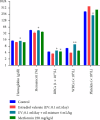Fertility-Enhancing Potential of P. amygdalas and J. regia Oil Mixture in Wistar Rats: Male/Female Infertility Models Assessment
- PMID: 40330801
- PMCID: PMC12055324
- DOI: 10.1155/sci5/3936227
Fertility-Enhancing Potential of P. amygdalas and J. regia Oil Mixture in Wistar Rats: Male/Female Infertility Models Assessment
Abstract
Polyunsaturated fatty acids-rich nuts are a group of natural sources that have served as a tonic in the treatment of many ailments for centuries. In this regard, P. amygdalas and J. regia nuts are traditionally used in infertility treatments. However, so far, the main mechanisms for the fertility-enhancing effects of these nuts in males/females are unknown. The present study was intended to evaluate the fertility-boosting effect of a mixture constituting P. amygdalas and J. regia oil on male/female infertility models and in two successive generations of rats; F 0 (parents) and F 1 (offspring). For the fertility assessment, male and female rats, 18 pairs (n = 36, 1:1, F 0 generation), were separated into three groups and dosed with 2 and 4 mL/kg daily of oil mixture and saline, respectively, from precohabitation up to lactation. To determine the further protective role of the oil mixture in infertility, we designed ethanol-induced male and estradiol-induced female infertility models. Various parameters like hormonal, hematological, lipid profile, and antioxidant markers [superoxide dismutase (SOD), glutathione peroxidase (GPx)] were measured along with histopathology of sex organs. The continual exposure of F 0 and F 1 generations to the oil mixture did not affect the fertility index and survival index in females. However, in males, all sperm parameters were significantly improved in both generations. We have found pronounced fertility outcomes with oil mixture supplementation in both genders of F 0 and F 1 generations. Results showed that the oil mixture significantly restored (p < 0.05) luteinizing hormone (LH), follicular stimulating hormone, GPx, plasma testosterone, and SOD activities in both models. Histological findings endorsed enhanced folliculogenesis and spermatogenesis with enhanced architecture. Our results strongly suggest that P. amygdalas and J. regia oil mixture might be a promising option in future for male/female sterility treatment. This finding could pave the way in infertile men and women for clinical trials. This is the first study that has provided an experimental rationale for a walnut and almond oil mixture combination as an effective candidate for fertility recovery by improving sex hormones and managing oxidative stress.
Keywords: almond; fertility; mixture; oxidative stress; sex hormones; two-generation study; walnut.
Copyright © 2025 Sadia Suri Kashif et al. Scientifica published by John Wiley & Sons Ltd.
Conflict of interest statement
The authors declare no conflicts of interest.
Figures











Similar articles
-
A two-generational reproductive study to assess the effects of Juglans regia on reproductive developments in the male and female rats.Braz J Biol. 2023 Nov 20;83:e275534. doi: 10.1590/1519-6984.275534. eCollection 2023. Braz J Biol. 2023. PMID: 38055579
-
Fertility-enhancing effects of Prunus amygdalas oil on reproductive functions of male rats: A two-generation study.Avicenna J Phytomed. 2025 Jan-Feb;15(1):816-837. doi: 10.22038/AJP.2024.24590. Avicenna J Phytomed. 2025. PMID: 40271497 Free PMC article.
-
The beneficial effect of Allium Cepa bulb extract on reproduction of rats; A two-generation study on fecundity and sex hormones.PLoS One. 2024 Mar 14;19(3):e0294999. doi: 10.1371/journal.pone.0294999. eCollection 2024. PLoS One. 2024. PMID: 38483938 Free PMC article.
-
Endocrine approaches to male fertility control.Baillieres Clin Endocrinol Metab. 1987 Feb;1(1):113-31. doi: 10.1016/s0950-351x(87)80055-1. Baillieres Clin Endocrinol Metab. 1987. PMID: 3297020 Review.
-
The Roles of Luteinizing Hormone, Follicle-Stimulating Hormone and Testosterone in Spermatogenesis and Folliculogenesis Revisited.Int J Mol Sci. 2021 Nov 25;22(23):12735. doi: 10.3390/ijms222312735. Int J Mol Sci. 2021. PMID: 34884539 Free PMC article. Review.
References
-
- Sun H., Gong T.-T., Jiang Y.-T., Zhang S., Zhao Y.-H., Wu Q.-J. J. A. Global, Regional, and National Prevalence and Disability-Adjusted Life-Years for Infertility in 195 Countries and Territories, 1990–2017: Results From a Global Burden of Disease Study, 2017. Aging (Albany NY) . 2019;11(23):10952–10991. doi: 10.18632/aging.102497. - DOI - PMC - PubMed
LinkOut - more resources
Full Text Sources

